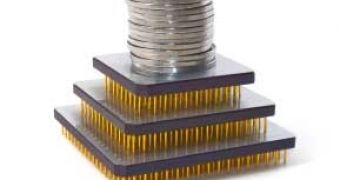Intel has just posted its revenue for the first quarter ended March 31. Intel managed to achieve higher than expected revenue, but less profit, which should be taken as a sign that the company is starting to spend a little more.
As compared to AMD, Intel is still doing fine, and it has even managed to snatch a bigger slice of market share on the MP server market between Q4 2007 and Q1 2008. Intel's expansion on the server market is extremely bad news for its Arch-rival AMD, given the fact that most of its revenue comes from the very same sector.
Intel's CEO Paul Otellini refused to give any estimations on the company's market share gains, and said that he would wait until the analysts' results kick in. Otellini only claimed that it was a "very strong quarter for server chips", mainly due to the production ramping in the company's Caneland server platform, powered by Intel's Xeon Tigerton 7300 processors.
According to the revenue report, Intel managed to squeeze $4.8 billion in CPU and chipset sales, a 15 percent increase over the first quarter of 2007. Intel also said that most of the revenue is due to the fact that the 45-nanometer technology allowed the company to cut down on average costs.
Mercury Research analyst Dean McCarron claims that Intel enjoyed a larger market share in the server CPU business than usually, mainly because AMD was unable to deliver its B2 revision of the Barcelona Opteron family on time. "The server market is very sensitive to stability issues," McCarron said.
At the same time, Intel was promoting its quad-core processors in an extremely aggressive manner, especially its quad-core Xeon parts, that were the quarter's bestsellers. More than that, the vast majority of the Xeon line-up is now built using the 45-nanometer production node, which gives them an efficiency advantage over AMD's Barcelona chips.

 14 DAY TRIAL //
14 DAY TRIAL //